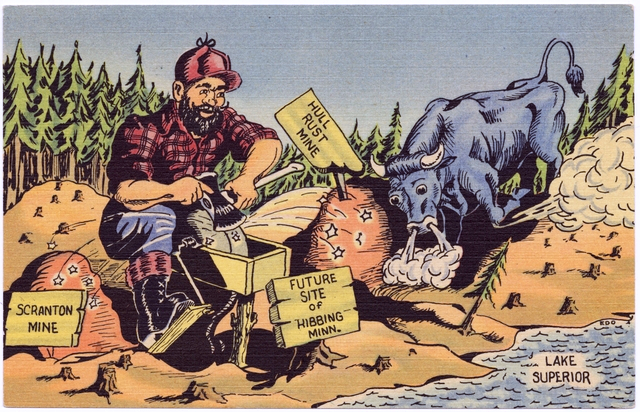The stories of Paul Bunyan had their beginnings in the camps of North American loggers in the mid-1800s. These stories, shared to build community, entertain and teach lessons, circulated among Scandinavian (primarily Swedish and Norwegian), German and Irish immigrants to the upper Great Lakes, including northern Minnesota. The timber cruisers (appraisers) of the Great Lakes, employed by logging companies to survey forests and collect information, played a key role in the spread of Paul Bunyan tales. During the winter of 1885–1886, timber cruisers of Rhinelander, Wisconsin, shared the first Paul Bunyan stories we recognize today.
The first published, though uncredited, account of Paul Bunyan appeared in a Duluth News Tribune article from 1904 that told the story of “the decline of the great American Lumber Jack.” This article references a “series of imaginative tales about the year Paul Bunyan lumbered in North Dakota,” during the year of the “blue snow.”
Then, in 1914, William B. Laughead popularized Paul Bunyan through a promotional pamphlet for the Red River Lumber Company. This pamphlet was reproduced as a second edition in 1916 and as a third edition in 1922, expanding Bunyan’s reach. This first pictorial representation of the Bunyan character, as a corporate mascot of sorts, promoted the company’s move from the Northwoods of Minnesota to Westwood, California.
Only a decade later, in 1925, James Stevens published his best-selling collection of Paul Bunyan tales. The book detailed how Bunyan had rescued a giant blue ox calf (Babe) from a frozen bay and adopted it as a companion. Babe, Bunyan, and a lumberjack crew then traveled around the U.S., felling trees across an “empty” landscape. Another volume described them creating the Great Lakes (Babe’s footprints), the Mississippi River (water from Bunyan’s tank), and the Red River (tinted by their spilled ketchup). These myths imagined that Minnesota’s waterways were new, and created by immigrants. They displaced Native creation stories, which said that Gichi Manitou (Ojibwe) and Wakaŋ Taŋka (Dakota) had made the rivers and lakes.
By the late 1900s, Paul Bunyan’s legendary figure was marked on the landscape of Minnesota: the 115-mile long Paul Bunyan Trail; the Paul Bunyan State Forest in Hubbard and Cass Counties; Paul Bunyan Land in Brainerd and Paul Bunyan Mall in Bemidji. Roadside stands, statues, murals and eateries used his image. As his myth spread, however, it overshadowed the ongoing cost of logging to Minnesota’s people and environment.
Paul Bunyan is credited with logging the “Northwoods,” a vast geography that spans the international border with Canada from New England to the Great Lakes, and west to the Pacific coast. In Minnesota, it was the state’s vast stands of white pine that drew loggers near, far, and fictional. The state’s first sawmill, the Marine Lumber Company, opened on the St. Croix River in 1839, and it was not long before logging made its way north. The “golden days” of logging began.
![]() The loggers who came to northern Minnesota in the mid-1800s found not the empty forests of Bunyan myths but a network of established Ojibwe communities. Lumber companies were able to build their camps only after a series of treaties (1837, 1854, and 1855) transferred prime pinelands away from Ojibwe nations and into the hands of the federal government. Bunyan stories also leave out the destruction that followed. The state’s vast pine forests were depleted by 1930, and lumber companies moved out of the state. Clearcutting left woodlands vulnerable to uncontrolled burning, leading to disasters like the Cloquet Fire of 1918. And dams created by loggers destroyed so many wild rice beds in north-central Minnesota that the Bois Forte Ojibwe had to abandon their homes.
The loggers who came to northern Minnesota in the mid-1800s found not the empty forests of Bunyan myths but a network of established Ojibwe communities. Lumber companies were able to build their camps only after a series of treaties (1837, 1854, and 1855) transferred prime pinelands away from Ojibwe nations and into the hands of the federal government. Bunyan stories also leave out the destruction that followed. The state’s vast pine forests were depleted by 1930, and lumber companies moved out of the state. Clearcutting left woodlands vulnerable to uncontrolled burning, leading to disasters like the Cloquet Fire of 1918. And dams created by loggers destroyed so many wild rice beds in north-central Minnesota that the Bois Forte Ojibwe had to abandon their homes.
The Native people who shaped the state’s logging history — as workers, residents, and land stewards — are missing from Bunyan lore. While Bunyan’s fictional crew is European American, Native men also labored in logging camps. Logging was exhausting and dangerous work. Yet it allowed many Native workers to enter the wage economy and remain close to their homelands. Other Native people, meanwhile, created Paul Bunyan tales of their own. By the late 1900s, Ojibwe storytellers explained the preservation of forests at Red Lake by saying that Bunyan had lost a fight with Nanabozho, the mythical Ojibwe trickster hero who predated him.
For more information on this topic, check out the original entry on MNopedia.






